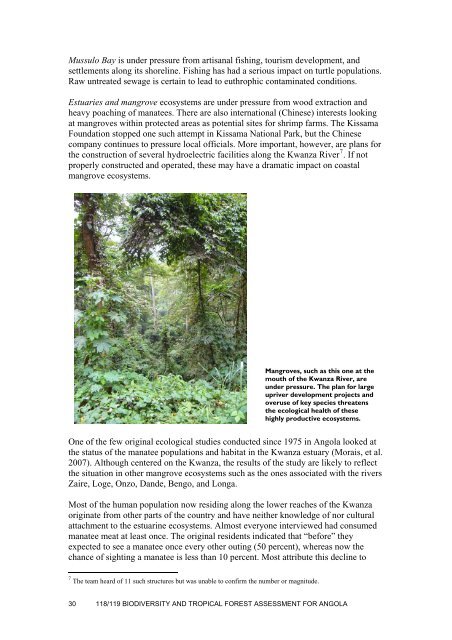118/119 Biodiversity and Tropical Forest Assessment for Angola
118/119 Biodiversity and Tropical Forest Assessment for Angola
118/119 Biodiversity and Tropical Forest Assessment for Angola
- No tags were found...
Create successful ePaper yourself
Turn your PDF publications into a flip-book with our unique Google optimized e-Paper software.
Mussulo Bay is under pressure from artisanal fishing, tourism development, <strong>and</strong>settlements along its shoreline. Fishing has had a serious impact on turtle populations.Raw untreated sewage is certain to lead to euthrophic contaminated conditions.Estuaries <strong>and</strong> mangrove ecosystems are under pressure from wood extraction <strong>and</strong>heavy poaching of manatees. There are also international (Chinese) interests lookingat mangroves within protected areas as potential sites <strong>for</strong> shrimp farms. The KissamaFoundation stopped one such attempt in Kissama National Park, but the Chinesecompany continues to pressure local officials. More important, however, are plans <strong>for</strong>the construction of several hydroelectric facilities along the Kwanza River 7 . If notproperly constructed <strong>and</strong> operated, these may have a dramatic impact on coastalmangrove ecosystems.Mangroves, such as this one at themouth of the Kwanza River, areunder pressure. The plan <strong>for</strong> largeupriver development projects <strong>and</strong>overuse of key species threatensthe ecological health of thesehighly productive ecosystems.One of the few original ecological studies conducted since 1975 in <strong>Angola</strong> looked atthe status of the manatee populations <strong>and</strong> habitat in the Kwanza estuary (Morais, et al.2007). Although centered on the Kwanza, the results of the study are likely to reflectthe situation in other mangrove ecosystems such as the ones associated with the riversZaire, Loge, Onzo, D<strong>and</strong>e, Bengo, <strong>and</strong> Longa.Most of the human population now residing along the lower reaches of the Kwanzaoriginate from other parts of the country <strong>and</strong> have neither knowledge of nor culturalattachment to the estuarine ecosystems. Almost everyone interviewed had consumedmanatee meat at least once. The original residents indicated that “be<strong>for</strong>e” theyexpected to see a manatee once every other outing (50 percent), whereas now thechance of sighting a manatee is less than 10 percent. Most attribute this decline to7 The team heard of 11 such structures but was unable to confirm the number or magnitude.30 <strong>118</strong>/<strong>119</strong> BIODIVERSITY AND TROPICAL FOREST ASSESSMENT FOR ANGOLA
















